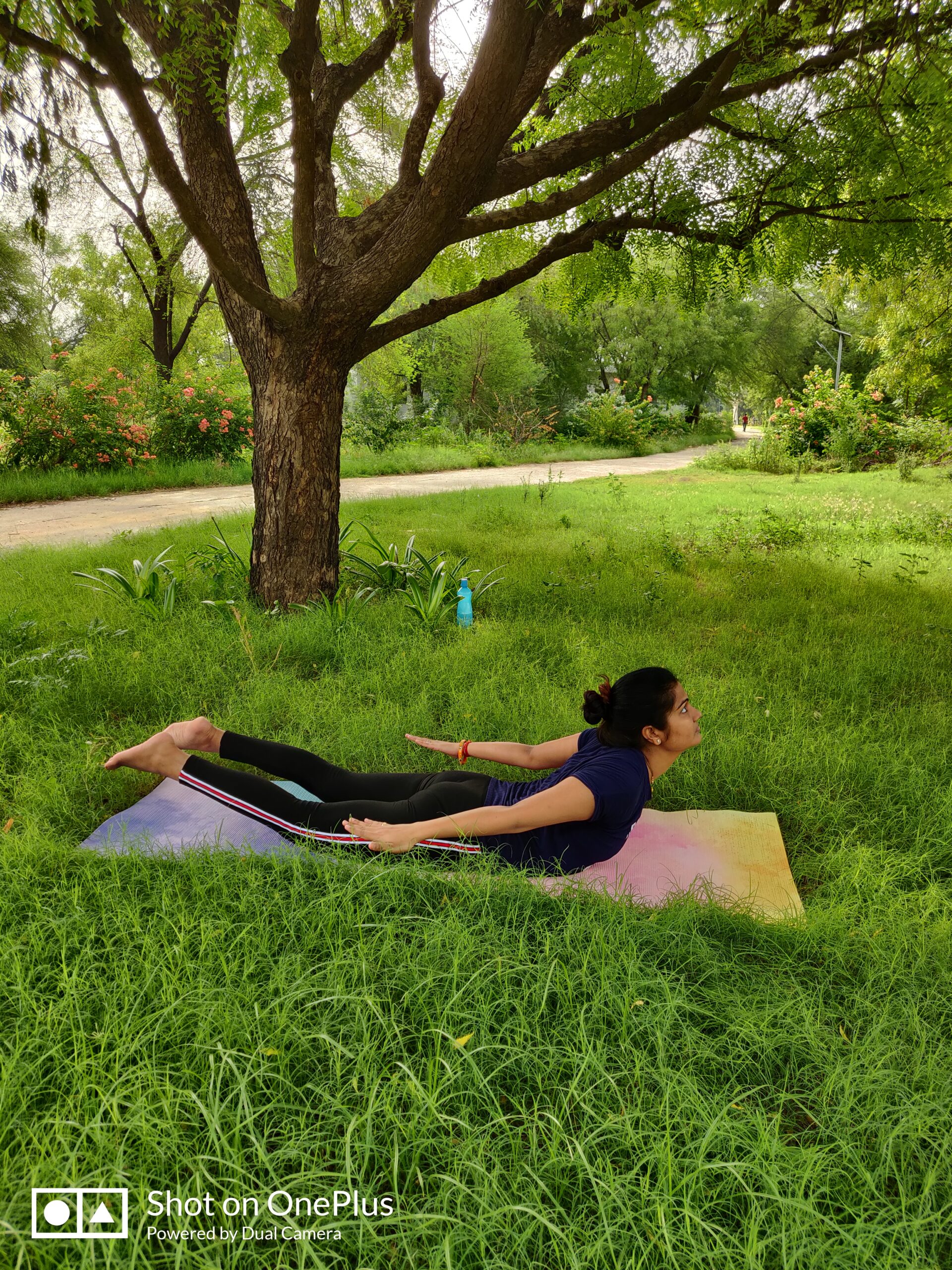Introduction: Osteoarthritis, a degenerative joint condition, can bring discomfort and limitations to daily life. While conventional treatments offer relief, naturopathic approaches provide a holistic perspective that targets the root causes of osteoarthritis. In this comprehensive article, we delve into naturopathic treatments and therapies that can effectively alleviate symptoms, improve joint function, and enhance overall well-being for individuals living with osteoarthritis.
Causes of Osteoarthritis: Unraveling the Factors
Osteoarthritis is a degenerative joint disorder characterized by the gradual breakdown of joint cartilage. Understanding the underlying causes of osteoarthritis is crucial for effective management and prevention. In this section, we explore the primary causes of osteoarthritis and the factors that contribute to its development.
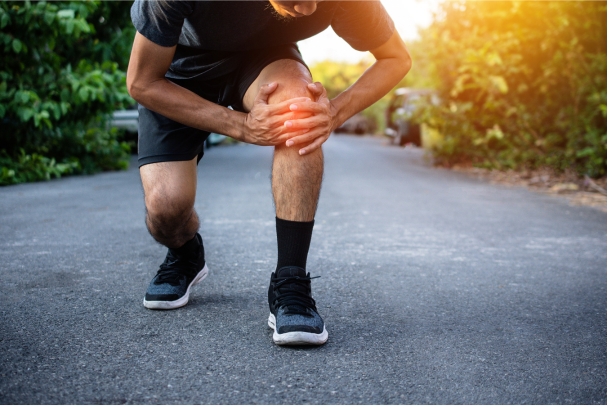
1. Age: As we age, the cartilage that cushions our joints naturally wears down, increasing the risk of osteoarthritis.
2. Genetics: Family history plays a role in osteoarthritis susceptibility. If your parents or grandparents had osteoarthritis, you may be at a higher risk.
3. Joint Injuries: Previous joint injuries, such as fractures or ligament tears, can increase the likelihood of developing osteoarthritis in the affected joint.
4. Obesity: Excess body weight puts additional stress on weight-bearing joints like the knees and hips, accelerating the breakdown of cartilage.
5. Repetitive Use: Activities that involve repetitive joint movements, such as bending, kneeling, or squatting, can contribute to cartilage wear and tear.
6. Joint Misalignment: Uneven distribution of weight across joints due to misalignment or structural abnormalities can contribute to cartilage degeneration.
7. Hormonal Changes: Hormonal changes, particularly those related to estrogen in women, may play a role in the development of osteoarthritis.
8. Sedentary Lifestyle: Lack of physical activity and muscle weakness can lead to joint instability and increase the risk of osteoarthritis.
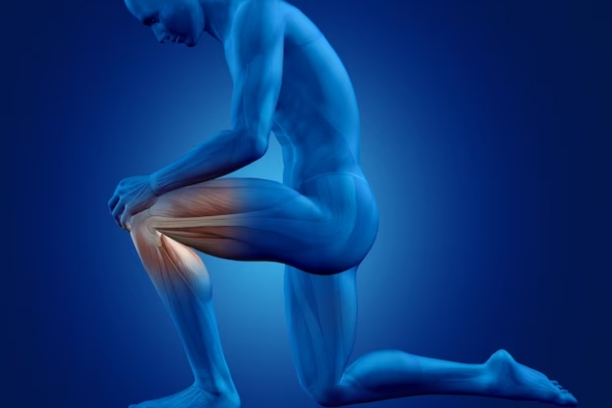
Symptoms of Osteoarthritis: Recognizing the Signs
Osteoarthritis manifests primarily in the joints and can significantly impact daily life. Recognizing the symptoms is essential for timely intervention and management. In this section, we explore the common symptoms associated with osteoarthritis.
1. Joint Pain: Pain, often described as aching or stiffness, is a hallmark symptom of osteoarthritis. It typically worsens with activity and improves with rest.
2. Joint Stiffness: Stiffness is most noticeable upon waking up or after prolonged periods of inactivity. Joints may feel stiff and difficult to move.
3. Reduced Range of Motion: Osteoarthritis can limit the ability to fully move joints, leading to a reduced range of motion.
4. Joint Swelling: Inflammation in the affected joint can cause swelling, resulting in increased joint size and discomfort.
5. Joint Crepitus: A sensation of grinding or grating within the joint, known as crepitus, can be felt when moving the affected joint.

6. Joint Instability: Osteoarthritis can lead to joint instability, making joints feel weak and prone to giving way.
7. Muscle Weakness: Weakness in the muscles surrounding the affected joint can contribute to pain and reduced joint support.
8. Reduced Functionality: Osteoarthritis can impact the ability to perform daily activities, such as walking, climbing stairs, or grasping objects.
9. Joint Deformities: In advanced cases, osteoarthritis can cause joint deformities, such as the development of bony growths (osteophytes) around the joint.
10. Pain Relief with Rest: Unlike inflammatory arthritis, pain associated with osteoarthritis tends to improve with rest.
11. Joint Warmth: Joints affected by osteoarthritis may feel warm to the touch due to mild inflammation.
Naturopathic Treatments and Therapies for Osteoarthritis Relief:
Osteoarthritis, a degenerative joint condition, can bring discomfort and limitations to daily life. While conventional treatments offer relief, naturopathic approaches provide a holistic perspective that targets the root causes of osteoarthritis. In this section, we delve into naturopathic treatments and therapies that can effectively alleviate symptoms, improve joint function, and enhance overall well-being for individuals living with osteoarthritis.
1. Nutritional Support:
- Anti-Inflammatory Diet: Emphasizing whole foods, rich in antioxidants and omega-3 fatty acids, helps reduce inflammation and alleviate joint pain.
- Turmeric and Ginger: These anti-inflammatory spices can be incorporated into meals or consumed as teas.
2. Herbal Medicine:
- Boswellia (Boswellia Serrata): Known for its anti-inflammatory properties, boswellia extract can reduce joint pain and improve mobility.
- Devil’s Claw (Harpagophytum Procumbens): This herb has been used for centuries to alleviate joint pain and stiffness.
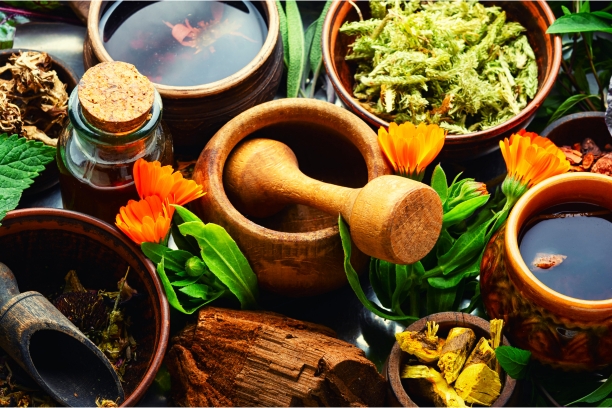
3. Hydrotherapy:
- Contrast Baths: Alternating between hot and cold water baths can promote blood circulation and reduce joint inflammation.
- Epsom Salt Soaks: Epsom salt baths can relax muscles, reduce pain, and improve joint mobility.

4. Physical Therapies:
- Joint Mobilization: Gentle joint mobilization techniques can improve joint flexibility and alleviate stiffness.
- Exercise Prescription: Customized exercise plans focus on strengthening the muscles around affected joints, providing better support.
5. Mind-Body Techniques:
- Yoga and Tai Chi: Gentle movements and stretching improve flexibility, joint function, and overall well-being.
- Meditation and Relaxation: Mindfulness practices reduce stress and help manage pain perception.
6. Acupuncture:
- Pain Management: Acupuncture sessions target specific points to relieve pain and improve energy flow.
- Reduced Inflammation: Acupuncture can also stimulate the body’s natural anti-inflammatory response.

7. Herbal Compresses and Topical Treatments:
- Comfrey and Arnica: These herbs can be used in compresses or creams to alleviate pain and reduce inflammation.
- Capsaicin Cream: Derived from chili peppers, capsaicin cream can provide temporary pain relief.
8. Nutritional Supplements:
- Glucosamine and Chondroitin: These supplements support joint health and may help alleviate osteoarthritis symptoms.
- Omega-3 Fatty Acids: Omega-3 supplements have anti-inflammatory effects that benefit joint health.
9. Manual Therapies:
- Osteopathic Manipulative Treatment (OMT): OMT involves hands-on techniques to improve joint mobility and reduce pain.
- Chiropractic Care: Chiropractors use spinal adjustments to enhance nerve function and promote overall wellness.
10. Lifestyle Modifications:
- Weight Management: Maintaining a healthy weight reduces stress on joints and minimizes pain.
- Stress Reduction: Stress management techniques, such as deep breathing and meditation, positively impact pain perception.
11. Detoxification:
- Detox Diets: Cleansing diets can support the body’s natural detoxification processes and reduce inflammation.
- Hydration: Drinking ample water helps flush out toxins and maintains joint lubrication.

12. Collaborative Care:
- Integration with Conventional Care: Naturopathic approaches complement conventional treatments, enhancing the overall management of osteoarthritis.
- Consultation with a Naturopath: Seeking guidance from a licensed naturopathic doctor ensures personalized treatment plans and safety.
Yogic Management for Osteoarthritis Relief: Enhancing Mobility and Comfort
Yoga, an ancient practice that combines physical postures, breath control, and mindfulness, offers a holistic approach to managing osteoarthritis. By improving joint flexibility, reducing inflammation, and promoting relaxation, yogic practices can significantly alleviate symptoms and enhance overall well-being for individuals living with osteoarthritis. In this section, we delve into specific yogic asanas and techniques that contribute to osteoarthritis relief.
1. Tadasana (Mountain Pose):
- Benefits: Tadasana improves posture, strengthens leg muscles, and enhances overall body awareness.
- Practice: Stand tall with feet hip-width apart. Lift and spread your toes, then ground them back down. Engage your thigh muscles and lengthen your spine.
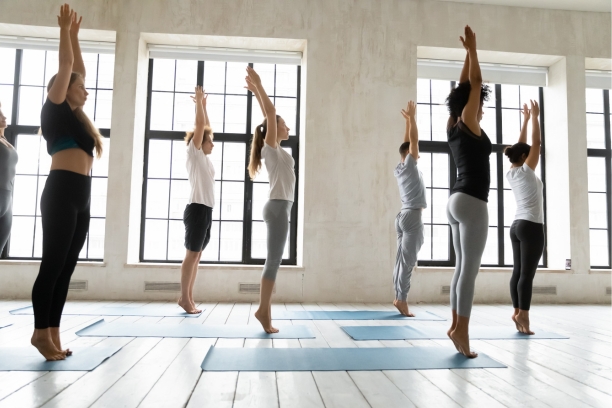
2. Vrikshasana (Tree Pose):
- Benefits: Tree pose enhances balance and strengthens the muscles of the legs and core.
- Practice: Stand on one leg, placing the sole of your foot against the inner thigh of the opposite leg. Bring your hands to your heart center and find a steady gaze point.

3. Virabhadrasana II (Warrior II Pose):
- Benefits: Warrior II stretches the hips, strengthens the legs, and improves overall stability.
- Practice: Step your feet wide apart, turn one foot out, and bend the front knee. Extend your arms parallel to the ground and gaze over your front hand.

4. Bhujangasana (Cobra Pose):
- Benefits: Cobra pose strengthens the muscles of the back and spine while improving flexibility.
- Practice: Lie on your stomach, place your hands under your shoulders, and lift your chest while keeping your pelvis grounded.
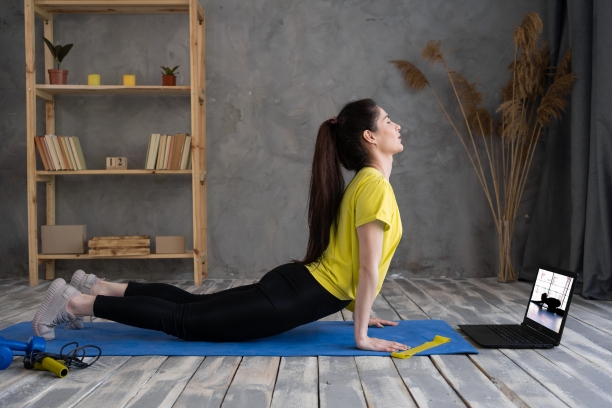
5. Setu Bandhasana (Bridge Pose):
- Benefits: Bridge pose opens the chest, stretches the spine, and strengthens the glutes.
- Practice: Lie on your back with knees bent and feet hip-width apart. Press into your feet and lift your hips off the ground.
6. Marjariasana-Bitilasana (Cat-Cow Pose):
- Benefits: Cat-cow pose enhances spinal flexibility, releases tension, and improves joint mobility.
- Practice: Move between arching your back (cow pose) and rounding your back (cat pose) in sync with your breath.
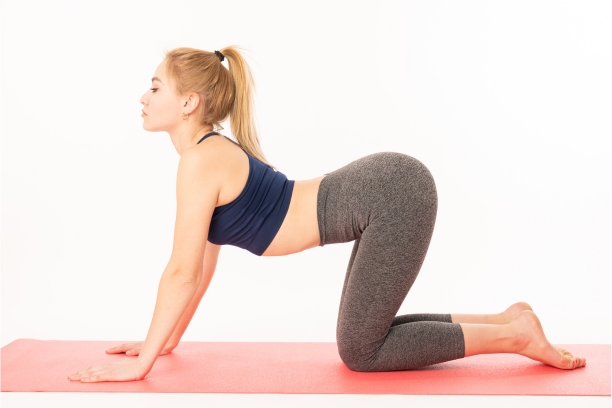
7. Shavasana (Corpse Pose):
- Benefits: Shavasana promotes relaxation, reduces stress, and allows the body to fully integrate the benefits of the practice.
- Practice: Lie on your back with arms at your sides and palms facing up. Relax your entire body and focus on deep, mindful breaths.
8. Pranayama (Breath Control):
- Deep Breathing: Slow, deep breaths promote relaxation and reduce stress, enhancing overall well-being.
- Nadi Shodhana (Alternate Nostril Breathing): Balances energy flow and calms the mind.

9. Meditation and Mindfulness:
- Benefits: Meditation reduces stress, enhances pain perception, and improves overall mental well-being.
- Practice: Find a quiet space, sit comfortably, and focus your attention on your breath or a specific mantra.
10. Stress Reduction and Mind-Body Connection:
- Yoga Nidra: A guided relaxation practice that reduces stress and enhances restorative sleep.
- Mindfulness: Practicing present moment awareness reduces stress and enhances the body’s natural healing processes.
11. Practice Caution:
It’s important to approach yoga practice with caution, especially if you have severe joint damage. Consult a certified yoga instructor and your healthcare provider before beginning any new practice. Yoga should be adapted to your individual needs and abilities.
Understanding Osteoarthritis
Unraveling the Degeneration : Osteoarthritis results from the breakdown of cartilage in the joints, leading to pain, stiffness, and reduced mobility.
Common Risk Factors: Various factors, including age, genetics, joint injuries, obesity, and repetitive use, contribute to the development of osteoarthritis.
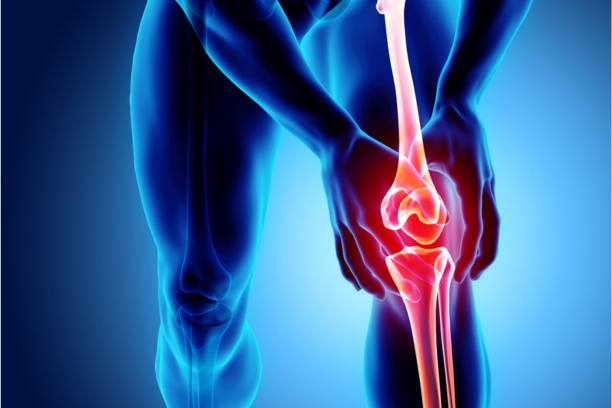
Conclusion:
Naturopathic treatments and therapies provide a multifaceted approach to managing osteoarthritis.Understanding the causes and symptoms of osteoarthritis is pivotal for accurate diagnosis, timely intervention, and effective management.Naturopathic treatments and therapies offer a comprehensive and individualized approach to osteoarthritis relief.Yogic management for osteoarthritis involves gentle practices that improve joint flexibility, reduce inflammation, and enhance overall well-being. Integrating these practices into your routine can contribute to improved joint function, reduced pain, and a greater sense of ease in daily activities.




